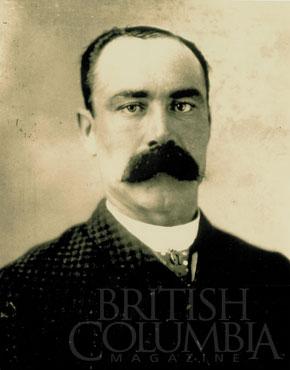
The Spring 2010 issue of British Columbia Magazine includes “150 years of light,” a short article about the first two lighthouses on Canada’s West Coast?Fisgard and Race Rocks. Dale Mumford of Fort Rodd Hill and Fisgard Lighthouse National Historic Sites of Canada has done extensive research on the history of these two beacons, and shares with us his profiles of the first and last keepers at Fisgard Lighthouse.
George Davies
The year was 1860. The good ship Grecian, seven months out of the port of London, England, was on the last leg of her voyage. Through his pocket telescope, George Davies could see a small brick tower on tiny Fisgard Island at the mouth of Esquimalt Harbour, and a taller stone tower on Race Rocks to the southwest.
He and his wife, Rosina, had travelled halfway around the world to see these two lighthouses and to be their caretakers. They had made a great sacrifice in bringing along only two of their three children. When their son George Davies Jr. fell ill just before their ship left England, they had been forced to leave him behind with relatives.
Deep in the hold of the Grecian were crates containing the lanterns and lighting apparatus that would bring these lighthouses to life. The equipment had been fabricated in England by Davies’s former employer, Wilkins and Co., Lighthouse Engineers.
In the weeks that followed, Davies supervised the fitting of the lighting equipment in both towers, including the two delicate Fresnel lenses that would magnify and concentrate light from oil-burning lamps. On November 16, 1860, he climbed the spiral staircase in the tower of Fisgard Lighthouse and lit the lamp for the first time. His wife, Rosina, shared responsibility for tending the light in four-hour shifts.
They spent only a few weeks at Fisgard before moving to Race Rocks in February 1861. Still missing their son (the colonial lighthouse board secretary had been unable to find someone willing to bring the child out to Vancouver Island), the family suffered a tragedy in 1865. On Christmas Day, they gathered outside to greet a boatload of friends and relations coming to share the holiday with them. Only a few yards from the shore, the boat was caught in a whirlpool and capsized, drowning all on board. The lighthouse boat had been taken away for repairs and the Davies were powerless to help.
Then, in 1866 George became seriously ill. Although his wife tried repeatedly to attract the attention of passing ships for assistance, there was no signal system in place. Without medical assistance, George died a few days later, at age 35—never again to see his son, George Jr., who did later get passage to Victoria.
Josiah Gosse
Josiah Gosse had reason to be unhappy in 1909. Initially, he had been offered the position of lightkeeper at Fisgard Lighthouse at a salary of $500 per year, the same as the previous keeper. But now a letter had arrived explaining that the local agent could pay only $360 per year, with increases of $22.50 per year for good conduct. To add insult to injury, the Department of Marine and Fisheries would no longer provide coal for heating and cooking, either.
Still, the lighthouse was conveniently close to Gosse’s farm on the shore of Esquimalt Lagoon. He decided to take the job—one he would keep for the next 18 years.
Rather than move his family to the house on the island, which was beginning to look quite run down, he chose to row out in the evenings and spend his nights there tending the light. In a small boat, the trip could be challenging in rough weather, but Gosse was a Newfoundlander. He had grown up with the stormy North Atlantic and spent years both as the skipper of a sealing schooner in the Bering Sea and as a mate on CPR coastal steamships.
The light was easier to maintain in Gosse’s day. New kerosene-burning Diamond vapour lamps with incandescent mantles provided much brighter, more reliable light than the old wick-burning oil lamps George Davies had relied upon.
After Gosse passed the age for mandatory retirement, discussion began regarding installation of automatic lighting equipment. An AGA acetylene light, which did not need to be watched, was installed in August 1928—but Gosse manned the lighthouse until his retirement on December 15, 1928. He was 75.
A new exhibit showcasing the historic contribution of Fisgard and Race Rocks lighthouses opens this spring at Fisgard Lighthouse National Historic Site. For more information see the Parks Canada website.

